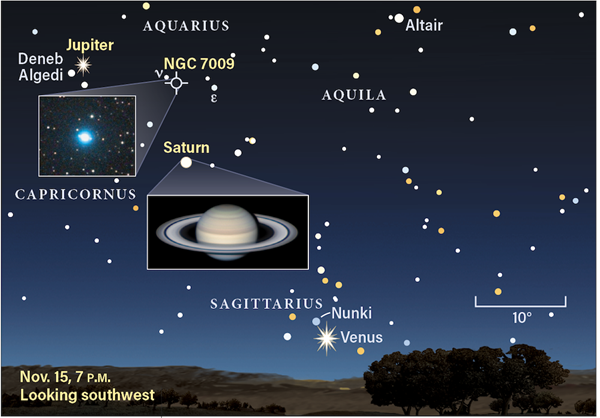This month, we voyage to a pair of Saturns — first the planet, then its namesake nebula. The planet currently resides in the constellation Capricornus, while the Saturn Nebula is conveniently located about 10° north-northeast in Aquarius. Both are positioned in the southwest sky after sunset.
Saturn reached opposition back in early August, but it’s still an impressive telescopic sight. In last month’s column, we toured the constellation Lyra with a 60mm (2.4-inch) refracting telescope. And with this same modest instrument and a magnifying power of just 30x, you can glimpse Saturn’s fabled rings. Because its glimmering rings are currently tilted at an angle of about 20°, Saturn resembles a flying saucer in a 1950s sci-fi movie. If the seeing conditions are ideal, increase magnification to 100-120x (the maximum useful power for a 2.4-inch scope) to reveal the rings so-called Cassini division, a dark gap in Saturn’s rings. The Cassini division, as well as Saturn’s subtle cloud belts, are more readily seen in scopes with twice the aperture and larger.
According to NASA, Saturn has 82 moons. Most of those are beyond the reach of backyard scopes, but a handful can be captured with small instruments. The easiest is Titan, that 8th-magnitude “star” visible in the same low-power field as Saturn. If you view Saturn and Titan nightly for a 16-day period, you can even track the moon through a complete orbit.
Saturn’s second largest moon, Rhea, is more challenging. It’s more than a magnitude fainter and never farther than two ring diameters from Saturn. To snare Rhea, wait for an evening when the moon is far off to Saturn’s side and seeing conditions allow for maximum small-scope magnification. If you can wait until 2025, Saturn’s rings will appear almost edge-on, cutting down on the planet’s overall glare. These tactics will likewise work if you’re attempting to target Saturn’s next two brightest moons: Tethys (magnitude 10.3) and Dione (magnitude 10.4). The annual RASC Observer’s Handbook includes a handy diagram showing the configurations of these satellites for any night of the year.
When you’re done admiring Saturn and nearby Jupiter — the latter shares Capricornus with Saturn; were you really going to ignore it? — turn your scope towards the Saturn Nebula. At magnitude 8.3, it’s too faint for the unaided eye, so you may want to use a telescope for this one. If your scope has GoTo technology, you can also simply key in its coordinates: R.A. 21h 04m 11s, Dec. -11° 21′ 49″. If it comes with a bonus deep-sky database, just punch in “Saturn Nebula” or “NGC 7009” and let your scope take you there.
For the die-hard star-hopper, the path to the Saturn Nebula begins at Nu (ν) Aquarii, a 4.5 magnitude star located about a degree to the east. With a low-power eyepiece in place, center Nu in the field and get it in sharp focus. Since you’ll want to move westward (the same way Nu is drifting across the field), move ahead of the star and continue about one degree (two Moon diameters) until an 8th-magnitude “star” enters the field. This should be the Saturn Nebula. To make sure, switch to a medium power (60-75x) eyepiece and play with the focus. If you get a crisp stellar image, it’s just a star and you’ll have to return to Nu to try again. If you instead see a small fuzzy ball, you’ve found the Saturn Nebula!
If you’re viewing the nebula with a modest scope, you might ask how it got its nickname. True, it’s about the same apparent size and shape as the planet Saturn. But it’s also bluish — and where are the rings?! The Saturn Nebula’s rings exist in the form of sideways extensions, or ansae, that indeed resemble the planet when viewing its rings edge-on. To see the Saturn Nebula’s “rings,” though, you’ll need a bigger scope. A 10-inch with a magnification of 250x should do the trick.
Like other planetary nebulae, the Saturn Nebula formed during the death of an average-sized star like the Sun. As its core collapsed, the star’s outer layers were blasted into space. But because this gaseous shell is still expanding and dissipating, the Saturn Nebula will only be visible for a few more thousand years. That might seem like a long time, but it’s really just a cosmic blink of an eye.
Questions, comments, or suggestions? Email me at gchaple@hotmail.com. Next month: The psychology of skygazing. Clear skies!










